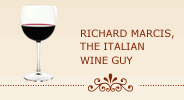Twenty Amazing Chianti and Chianti Classico Wines Under $40
In a recent posting I reviewed 15 of my all-time favorite inexpensive red wines from Italy. By inexpensive, I mean wines that retail for $20 or less. It is not as easy a task as it might first seem. Italy is a prolific producer of wines at all price points so there is an abundance of wines from which to select. Choosing only 15 wines is not easy and many wines I really enjoy did not make the cut-off - good perhaps but not good enough.
Now I’m going to up the ante and examine 20 of my favorite wines that retail in the $20 to $40 price range. But this time I’m going to limit my selections to just a special group of wines - Chianti and Chianti Classico wines. In making these selections I encountered some of the same problems as when I looked at wines under $20 - a dizzying number of high-quality wines from which to choose.
Every winery in Tuscany’s Chianti Classico region and the 7 Chianti sub-zones produces at least one Chianti wine and most produce several, especially when Riserva versions are included. So when you have a large group of quality wines from which to choose, choosing only a select few is not an easy task at all. But I slogged on and winnowed the list down to 20 Chianti and Chianti Classico wines that I think are simply amazing. These are wines that because of their balance, structure, richness and, yes, elegance have made an indelible impression on me. These are wines worth searching out on wine shop shelves.
Some Background
Typically, when people talk about Chianti wines they usually are referring to Chianti Classico wines. In Italy, the term “classico” generally refers to the oldest and/or the center of a zone or area. So the Chianti Classico zone, which lies between the popular tourist cities of Florence and Siena, is the oldest part and the center or heart of the general Chianti wine region.
The larger area surrounding the Classico zone is known simply as Chianti. This larger area has 7 specific sub-zones of Chianti, each with its own soil, microclimate, regulations as well as wine style preferences. The 7 sub-zones include Colli Aretini, Colli Senesi, Colline Pisane, Colli Forentini, Montalbano, Montespertoli and Rufina. On their wine labels, all put the Chianti name in front of their sub-zone appellation, e.g., Chianti Colli Senesi or Chianti Rufina.
But it is the Classico that is the premier Chianti region. It produces the most wine, a disproportionate portion of the highest quality wines and is the oldest and by far the most easily recognizable of the various Chianti wine regions. Chianti Classico achieved DOCG status in 1984.
The regulations governing the production of Chianti Classico wines have varied considerably over time. In 1995 the authorities established a new, more flexible set of regulations to govern production of Chianti Classico wines. In summary, these regulations emphasize that 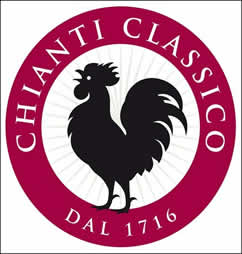 Sangiovese is the premier varietal and so Chianti Classico must include a minimum of 80 percent Sangiovese grapes and can go up to 100 percent. Native red grapes like Canaiolo or Mammolo or “international” varieties like Cabernet Sauvignon, Merlot or Syrah can be used to fill out up to 20 percent of the blend.
Sangiovese is the premier varietal and so Chianti Classico must include a minimum of 80 percent Sangiovese grapes and can go up to 100 percent. Native red grapes like Canaiolo or Mammolo or “international” varieties like Cabernet Sauvignon, Merlot or Syrah can be used to fill out up to 20 percent of the blend.
By 2006, it was no longer permissible to use any white grapes in production of Chianti Classico. Formerly, white varieties such as Trebbiano or Malvasia could be included up to 6 percent of the blend. For the first time, Chianti Classico wines also became eligible for ageing in small oak barrels (barriques). Finally, the regulations specified that Chianti Classico wines had to be approved by a tasting panel.
Many producers also make a Riserva version of their Chianti Classico. To qualify for a Riserva designation the wine has to have a minimum 12.5 percent alcohol compared with a minimum of 12 percent for the regular Chianti Classico. They must also be aged at the winery for a minimum of 24 months (compared with 12 months required for regular Chianti Classico) of which at least 3 months must be in bottle. The longer ageing protocol helps smooth out any rough edges and aids in developing more refined flavors.
Generally, Riserva wines are age-worthy wines with plenty of staying power. A Riserva from a quality-focused producer in a good vintage can last and be very enjoyable 20 to 25 years after the vintage date. As you might expect, they are also more expensive than regular Chianti Classico wines.
In February 2014, a new quality category for Chianti Classico called Gran Selezione was officially launched. Gran Selezione is a quality level above Riserva, the previous top category, and is the new apex of the Chianti Classico quality wine pyramid.
While Riserva wines have to be aged for at least 24 months before release, Gran Selezione wines must be aged even longer - 30 months minimum of which at least 3 must be in the bottle. Sangiovese grapes must still comprise at least 80 percent of the blend with other approved grape varieties permitted up to 20 percent of the blend.
An important change is that a Gran Selezione wine must be produced entirely with the winery’s own grapes selected from its finest vineyards. Consequently, firms that buy grapes from other producers or merchants, oftentimes in bulk and frequently of inferior quality, and bottle it under their own label will not qualify for Gran Selezione status.
Finally, Gran Selezione wines must also pass muster with an accredited tasting panel and must also submit to a chemical and physical analyses by an authorized lab.
Wines that meet these requirements will be able to display the Gran Selezione designation on the wine bottles. Gran Selezione wines have already started appearing on wine shop shelves and typically bear lofty prices commensurate with their elevated status. The Chianti Classico Wine Consortium estimates that Gran Selezione wines will account for about 10 percent of total Chianti Classico production.
The Wines
Listed below are my favorite Chianti and Chianti Classico wines in the $20 to $40 price range. Regardless of price they all also rank high on a quality-to-price basis. All the wines are available in major U.S. markets.
The wines are listed alphabetically by producer.
Castellare di Castellina, “Il Poggiale” Chianti Classico Riserva 2011 (about $36)
Poderi Castellare di Castellina is located close to the village of Castellina-in-Chianti, a major wine town in the heart of the Chianti Classico area.
The estate’s 2011 Il Poggiale Chianti Classico Riserva is a blend of Sangioveto (a clone of Sangiovese which some winemakers claim is far superior to Sangiovese) and 5 percent each of Canaiolo and Ciliegiolo. The wine is aged in small oak barriques for 12 to 18 months.
This Riserva is a Chianti Classico cru with all the grapes sourced from the Il Poggiale vineyard. The high elevation of the vineyard with its hot summer days and cool nights helps grapes develop good acidity, aromatic notes and more structured tannins. The microclimate in conjunction with a policy of strictly limiting yields can result in wines that combine both richness and elegance.
This wine is full-bodied with excellent structure and playful acidity all backed-up by a firm tannic backbone. This classic wine will reward longer ageing so for best results set it aside out of reach for a few more years.
Badia a Coltibuono, Chianti Classico Riserva 2009 (about $34)
The historic Badia a Coltibuono is located in Gaiole-in-Chianti in the eastern section of the Chianti Classico zone. The estate’s history dates back almost a millennium when an order of monks established an abbey (“Badia” in Italian) which still stands today on the estate’s property.
Made from organically-grown estate grapes, the 2009 Chianti Classico Riserva consists of 90% Sangiovese with other native red grapes comprising the residual. The wine has an intense, deep ruby red color and an intoxicating bouquet of red cherries accented with floral and spice notes. The wine has a traditional Chianti personality with velvety tannins, firm acidity and cherrystone bitterness on a lingering finish. It is well balanced, delicious and ready to drink now but will develop even more complexity with some additional ageing.
Brancaia, Chianti Classico Riserva 2011 (about $36)
La Brancaia is one of Tuscany’s top wine estates. Located close to the small, wine-centric town of Castellina-in-Chianti it produces a small number of Chianti Classico and Super-Tuscan wines. This Chianti Classico Riserva is a serial recipient of Gambero Rosso’s prestigious Tre Bicchieri (“three glasses”) award.
The excellent 2011 Brancaia Chianti Classico Reserva is a blend of 80 percent Sangiovese and 20 percent Merlot and it has earned high marks and scores from several prominent wine reviewers. This medium-bodied Riserva is rich and textured with ripe tannins, good acidity and fruit flavors. This wine deserves its high ratings.
Castello Banfi. Chianti Classico Riserva 2010 (about $20)
Made in a rich, smooth style, Banfi's Chianti Classico Riserva has vivid and silky cherry and dark fruit flavors with kitchen spice accents on the finish. It is an elegant and regal wine at a proletarian price.
Castello d’Albola, Chianti Classico Riserva 2010 (about $26)
Castello d’Albola is located in the beautiful wine-focused town of Radda-in-Chianti. The hills in this area are steeply sloped and the Castello d’Albola winery claims some of the highest vineyards in the Chianti Classico DOCG appellation. The winery has about 400 acres of vineyards and is one of the premier producers in the Zonin Italian wine consortium.
Only the best, hand-selected Sangiovese grapes are used in the estate’s 2010 Chianti Classico Riserva. The wine is aged for 2 years in oak, the first year in small French oak barriques and the second year in large botti casks and is bottled unfined and unfiltered.
This medium to full-bodied wine has excellent structure with prominent tannins, lively cherry and sweet herb flavours that gain intensity as this vibrant red builds to a lengthy, delicate finish.
It is a quality wine at a relatively modest price.
Castello di Verrazzano, Chianti Classico Riserva 2010 (about $40)
Castello di Verrazzano is one of the oldest and most storied estates in the Chianti region. The estate was the birthplace and home of the explorer Giovanni da Verrazzano who discovered New York Bay in the early 16th century. In recognition of his achievements, the prominent bridge linking Brooklyn and Staten Island was named after him.
But Castello di Verrazano’s elevated status in modern times is based on its lineup of outstanding wines, one of which is its Chianti Classico Riserva. It is only released in outstanding vintages and only hand-selected Sangiovese and some Canaiolo grapes from the best parts of the estate’s vineyards are used in its production. After fermentation the wine is aged for a minimum of 2 years in small oak barrels followed by 6 months additional ageing in the bottle.
This structured wine has subtle blackberry and balsamic aromas. It is rich and concentrated with black cherry and plum flavors and austere tannins that leave an indelible impression. The oak influence is present but measured and not overpowering.
The wine should be opened for 1-1/2 to 2 hours before serving. While ready to drink now, it will acquire additional character and complexity with additional time in the cellar.
Castello di Volpaia, Chianti Classico Riserva 2010 (about $30)
This Chianti Classico Riserva is made entirely of Sangiovese from the estate’s organically certified vineyards. This full-bodied wine is aged for two years in a combination of oak casks and small oak barriques. It is well-structured, complex and rich with dark fruit and spice aromas and soft tannins.
Felsina, Berardenga Chianti Classico Riserva 2011 (about $27)
This wine is made entirely of Sangiovese from the estate’s vineyards in Castelnuovo Berardenga which is a few miles east of Siena in the southeastern part of the Chianti Classico region. Fermented and macerated in stainless steel, the wine is aged from 12 to 16 months in medium-size oak barrels, bottled and then made available for sale after 3 to 6 months of bottle ageing.
This Chianti Classico Riserva is dark in color, rich with earthy and ripe dark fruit flavors supported by discernible tannins. An impressive effort from one of Chianti’s most reliable producers.
Fontodi, Chianti Classico 2010 (about $37)
Generally considered one of the finest wineries in Chianti, the Fontodi estate has a small but prestigious lineup of Chianti, Super-Tuscan and IGT wines. Fontodi has about 175 organically-certified acres under vine just outside the major wine-destination town of Panzano-in-Chianti.
Fontodi’s 2010 Chianti Classico is deep, rich and structured with discreet tannins and lots of juicy dark fruit flavors followed by an assertive grip on the finish. This wine has the stuffing to accompany most roasted, braised or barbequed red meats and would, for example, be an ideal match for Bistecca alla Fiorentina.
Isole e Olena, Chianti Classico Riserva 2011 (about $27)
Paolo De Marchi is the current winemaker and manager of this family estate. He is one of the principal stars in the Italian wine constellation, consistently producing some of the finest Chianti Classico and IGT Tuscan wines on the market.
The 2011 Chianti Classico Riserva is a blend of 80 percent Sangiovese, 15 percent Canaiolo and 5 percent Syrah, a blend that emphasizes finesse over power. It is medium-bodied wine with a dark ruby color and enticing red berry and floral aromas with some sweet spice notes. A silky texture, vibrant acidity and elegant tannins will keep you coming back for more.
Lamole di Lamole, Chianti Classico Riserva 2010 (about $31)
Lamole, a hamlet of Greve-in-Chianti, was initially colonized two centuries ago by the early Romans who recognized the area’s agriculture potential by establishing vineyards and olive groves in the surrounding hills. The Lamole di Lamole estate produces a small but prestigious line-up of Chianti Classico wines as well as Vinsanto and Grappa.
The estate’s 2010 Chianti Classico Riserva is a blend of Sangiovese and 5 percent Canaiolo. It opens with luxurious cherry fruit aromas with floral accents. This wine is full-bodied, rich and juicy with Sangiovese-driven tannins and firm acidity. It would be a welcome guest at any table where Osso Bucco or roast beef is on the menu.
Marchesi Antinori, “Villa Antinori” Chianti Classico Riserva 2011 (about $30)
This Chianti Classico Riserva is from one of Italy’s oldest and most distinguished wine producers. Aged in a combination of large casks and small oak barrels, it has intense aromas and flavors and light touches of oak from its wood ageing. It is one of the most popular and readily available Chianti Classico wines.
Marchesi de F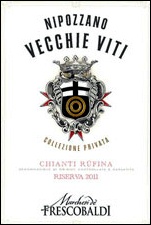 rescobaldi, “Nipozzano Vecchie Viti” Chianti Rufina Riserva 2011 (about $30)
rescobaldi, “Nipozzano Vecchie Viti” Chianti Rufina Riserva 2011 (about $30)
This wine from Frescobaldi’s Castello di Nipozzano estate in the Chianti Rùfina sub-zone of Chianti is aged for 24 months in oak barrels. It is full bodied, rich and complex and while ready to drink now it will continue to improve with further ageing.
Marchesi Mazzei Castello di Fonterutoli, “Ser Lapo” Chianti Classico Riserva 2011 (about $26)
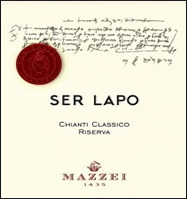 This enticing 90 percent Sangiovese and 10 percent Merlot blend bears the name of the Mazzei family’s 14th century ancestor who was the first to use the term “Chianti wine” in an official document. The wine is aged for 10 months in small French oak barrels and an additional 4 months in the bottle prior to release.
This enticing 90 percent Sangiovese and 10 percent Merlot blend bears the name of the Mazzei family’s 14th century ancestor who was the first to use the term “Chianti wine” in an official document. The wine is aged for 10 months in small French oak barrels and an additional 4 months in the bottle prior to release.
Nittardi, “Casanuova di Nittardi” Chianti Classico 2010 (about $32)
Fattoria Nitardi has 30 ideally-situated acres of vineyards midway between Siena and Florence. The owners are major art collectors and 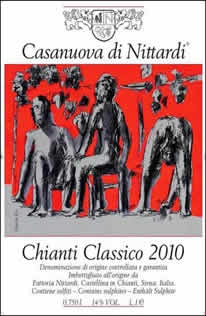 each year commission a famous artist to design the label for the latest Casanuova di Nittardi, the winery’s principal Chianti Classico wine. The bottle label for the 2010 vintage was designed by Dario Fo, a Nobel Prize winner in literature.
each year commission a famous artist to design the label for the latest Casanuova di Nittardi, the winery’s principal Chianti Classico wine. The bottle label for the 2010 vintage was designed by Dario Fo, a Nobel Prize winner in literature.
The 2010 Casanuova di Nittardi consists of Sangiovese with a splash of Canaiolo Nero, a local indigenous grape. It spends 6 months in used French oak barrels and a few months in the bottle prior to release for sale.
It is a well-crafted traditional Chianti Classico with enticing aromas redolent of red berries and a bouquet of violets. The medium to full-bodied wine exhibits lively acidity, firm tannic structure and a dry, spicy finish. The wine as well as the bottle label will elicit a rousing “thumbs-up” from your dinner companions.
Nozzole, Chianti Classico Riserva 2011 (about $22)
The Tenuta di Nozzole estate is located in the town of Greve-in-Chianti, the unofficial wine capital of the Chianti Classico zone. The estate’s Chianti Classico Riserva is made entirely of Sangiovese from their vineyards. It is aged for16 months in oak barrels and an additional 3 months in the bottle. The wine is complex and elegant and would be a welcome addition to any dining table.
Rocca della Macie, “Famiglia Zingarelli” Chianti Classico Riserva 2011 (about $25)
This is one of those under-the-radar-screen wines from the Chianti country that deserves more recognition. Famiglia Zingarelli’s Sangiovese flavor profile is enhanced by the addition of small amounts of Cabernet Sauvignon and Merlot. The wine has grip, food-friendly acidity and a richness that will prompt you to linger at the dining table.
Ruffino, "Riserva Ducale Oro" Chianti Classico Gran Selezione 2010 (about $35)
Ruffino’s Riserva Ducale Oro (Gold) Chianti Classico was first produced in 1947 to commemorate an outstanding vintage. It has been released for many years since then but only in exceptional vintages. If it’s not considered an exceptional vintage, the wine won’t be produced.
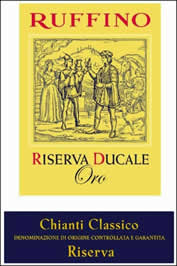 Oro is a blend of 80 percent Sangiovese and 10 percent each of Merlot and Cabernet Sauvignon. The wine is aged in oak, stainless steel and concrete vats for 36 months (yes, that’s 3 years, one year longer than required by the DOCG) and then spends 6 months in the bottle (3 months longer than DOCG requirements).
Oro is a blend of 80 percent Sangiovese and 10 percent each of Merlot and Cabernet Sauvignon. The wine is aged in oak, stainless steel and concrete vats for 36 months (yes, that’s 3 years, one year longer than required by the DOCG) and then spends 6 months in the bottle (3 months longer than DOCG requirements).
Ruffino’s Riserva Ducale Oro is dark, full-bodied, dry and lean with a well-defined structure and generous tannins. It takes a while for the flavors to warm up in the glass but once they do they're generous and rich with juicy black fruit and sweet red cherry accented with spice notes.
The Oro has an almost chewy texture and mouthfeel with good acidity and would have no trouble standing up to a rich, intense meal. This would be my wine of choice whenever wild boar is on the menu. It’s a lot of wine for what I consider a relatively modest price.
Selvapiana, “Bucerchiale” Chianti Rufina Riserva 2010 (about $34)
Fattoria Selvapiana is a low-profile Tuscan winery that deserves to move to the top of your wine list. Part of its low profile may be due to the low visibility of the Chianti Rufina wine region where the winery is located. While it is an historic and highly-regarded Chianti sub-zone northeast of Florence in the foothills of the Apennine Mountains, it is the smallest of the Chianti sub-zones and only has 22 producers. Rufina is also easily confused with the familiar Chianti Classico winery, Rufino. Chianti Rufina achieved DOCG status in 1984.
The Bucerchiale is the estate’s flagship wine and only released in the best vintages. It is crafted entirely of Sangiovese grapes from the estate’s Bucerchiale vineyard. The grapes are fermented and macerated for 25 days and then aged in a combination of new and used French oak barriques for 15 months.
This wine has a well-defined personality with complex aromas of berries and spices, dense dark fruit flavors, pronounced tannins and assertive acidity. The wine clocks in at 15 percent alcohol by volume.
This is a wine built for the long haul. The 2010 Bucerchiale is just now starting to exhibit its full character and has the potential to age well in your cellar for a couple of decades, that is if you can resist the temptation. It is a bargain at its current price.
Terrabianca, “Croce” Chianti Classico Riserva 2010 (about $29)
The Terrabianca estate has done extensive clonal research on different grape varieties in order to identify what varieties and clones grow best in particular microclimates and exposures. The estate’s 2010 “Croce” Chianti Classico Riserva consists of 6 different clones of specifically-selected Sangiovese along with a splash of Canaiolo. The wine is aged for 15 months in oak barrels and spends an additional 6 months in the bottle prior to release for sale.
This is a hearty, full-bodied wine, warm and spicy with a seductive texture. The mouthfeel is smooth and round with a load of blackberry and dark cherry flavors and sweet spice notes. It has a smooth and long finish that leaves you wanting for nothing.
Villa Cafaggio, Chianti Classico Riserva 2010 (about $25)
Villa Cafaggio is one of the most reliable producers in the Panzano area, one of the premier wine-producing locations in the Chianti Classico region. Cafaggio’s Riserva is made entirely of Sangiovese grapes from the estate’s vineyards. It is aged for 18 months in medium-size oak barrels, and then spends 3 months in the bottle prior to release for sale.
This wine is big and structured with a tannic backbone and plush black cherry spiced flavors guaranteed to get your full attention. This wine will gain complexity and nuanced flavors with additional ageing. Be patient and give it some time.
Note – prices indicated are averages of national retail prices but prices will vary from store to store. Since availability is not guaranteed and stores may sell out of the selections it is best to call or check their website for availability and price before making the trip.
©Richard Marcis
August 15, 2015
Return to italian wine reviews

